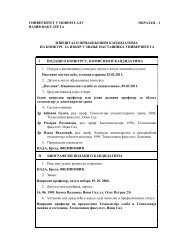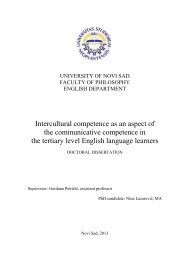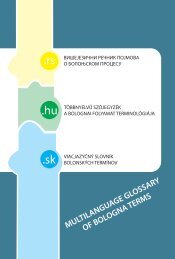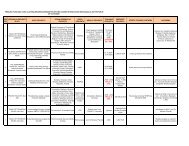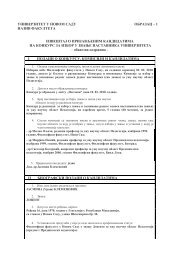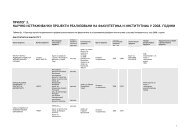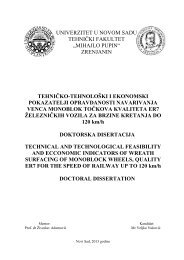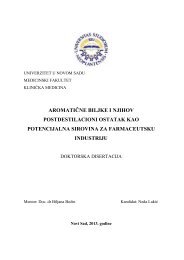- Page 1 and 2: UNIVERZITET U NOVOM SADU FILOZOFSKI
- Page 3 and 4: ZP Uže geografsko područje: Auton
- Page 5 and 6: Budući da su pedagozi zapaženo ra
- Page 7 and 8: University of Novi Sad Faculty of P
- Page 9: Abstract: AB The aims of the resear
- Page 13 and 14: 8.1.2. Hiperaktivnost .............
- Page 15 and 16: 10.5. Prosocijalno ponašanje .....
- Page 17 and 18: se od sledećeg: kultura na idealan
- Page 19 and 20: I TEORIJSKI PRISTUP PROBLEMU ISTRA
- Page 21 and 22: je „bilo koji oblik ponašanja us
- Page 23 and 24: njihovo ponašanje postane nasilno.
- Page 25 and 26: 1.4. Fizičko vaspitanje U literatu
- Page 27 and 28: 2. Značajna empirijska istraživan
- Page 29 and 30: Nasilje u školi se tokom 80 - tih
- Page 31 and 32: U Kanadi su Charach, Pepler i Ziegl
- Page 33 and 34: standardizovan i primenjivan u mnog
- Page 35 and 36: 3. Teorijski pristupi objašnjenju
- Page 37 and 38: U sredini u kojoj dete živi, raste
- Page 39 and 40: Na osnovu eksperimentalnih istraži
- Page 41 and 42: instiktivističkih teorija i pojavl
- Page 43 and 44: 2. Do učenja se može doći i na o
- Page 45 and 46: interpretacije i samoregulacije, na
- Page 47 and 48: Huesmann svoj model bazira na teori
- Page 49 and 50: 3.6. Biološke i fiziološke teorij
- Page 51 and 52: U istraživanju Holmberga (1977., p
- Page 53 and 54: Loeber (1990., prema: Essau i Conra
- Page 55 and 56: 5. Vrste agresije/nasilja Postoje n
- Page 57 and 58: je agresivna inhibicija manje pod u
- Page 59 and 60: Možemo konstatovati, da se o nasil
- Page 61 and 62:
7. Karakteristike učesnika u krugu
- Page 63 and 64:
- oboružani nasilnik (traži prili
- Page 65 and 66:
javlja se simpatija i empatija jer
- Page 67 and 68:
7.3. Karakteristike potencijalnih p
- Page 69 and 70:
Legenda: Slika br.2 Krug nasilja (p
- Page 71 and 72:
- Barkley (1997, 83) ukazuje da hip
- Page 73 and 74:
egulacije i inhibicije ponašanja.
- Page 75 and 76:
situacijama gde je prisutan veći b
- Page 77 and 78:
ekspresivnom govoru koji remete raz
- Page 79 and 80:
Kognitivni deficiti dece odnosi se
- Page 81 and 82:
uglavnom izjednačavaju sa agresivn
- Page 83 and 84:
Školski neuspeh Sniženo samopošt
- Page 85 and 86:
uspešno interpersonalno funkcionis
- Page 87 and 88:
pomaganje, poverenje, empatija i po
- Page 89 and 90:
Međutim, važno je napomenuti da t
- Page 91 and 92:
elaboracija, koja će dovesti do pr
- Page 93 and 94:
10.4. Situacioni faktori Intenzitet
- Page 95 and 96:
uzbuđenja, na koje će najviše de
- Page 97 and 98:
11. Pedagoške implikacije nasilja
- Page 99 and 100:
zamišljeni događaj o kojem mediji
- Page 101 and 102:
Karakteristike osobe koja gleda nas
- Page 103 and 104:
azvile odgovarajuće kompetencije i
- Page 105 and 106:
pojedinca“. Iterpretacija preko m
- Page 107 and 108:
socijalnih standarda ponašanja. NI
- Page 109 and 110:
12. Ekološki multidimenzionalni pr
- Page 111 and 112:
delotvorno korištenje nenasilnih p
- Page 113 and 114:
Samopoštovanje Nivoi delovanja: IV
- Page 115 and 116:
koncepta otpornosti nalazi se slede
- Page 117 and 118:
članova zajednice postoji u manjoj
- Page 119 and 120:
programa su dobro edukovani, lideri
- Page 121 and 122:
osvetljenja; smanjivanje veličine
- Page 123 and 124:
Učenje zamene agresije Program „
- Page 125 and 126:
povećana samorefleksija, gde bi u
- Page 127 and 128:
program, oni se prvo edukuju tokom
- Page 129 and 130:
Školsko osoblje se u okviru devet
- Page 131 and 132:
stvara potrebu za alternativama tu
- Page 133 and 134:
Formiranje Spoljašnje zaštitne mr
- Page 135 and 136:
Iskustva različitih zemalja pokazu
- Page 137 and 138:
komunikacije su potrebe sa kojima o
- Page 139 and 140:
saznanja, a to su upravo njihovi š
- Page 141 and 142:
Zapaženi pravci delovanja školski
- Page 143 and 144:
Uspešna prevencija zahteva da deca
- Page 145 and 146:
da grupna pravila, prerastu u norme
- Page 147 and 148:
15.2. Pedagoška radionica - oblik
- Page 149 and 150:
putem pokreta. Za vreme realizacije
- Page 151 and 152:
pravednosti, pravde, poštenja, na
- Page 153 and 154:
fizički, već i moralno i socijaln
- Page 155 and 156:
kome učenik teži, svest o sebi i
- Page 157 and 158:
upoznati učenike s onim vrstama fi
- Page 159 and 160:
podstiče razvoj specifičnih vešt
- Page 161 and 162:
Značaj nastave fizičkog vaspitanj
- Page 163 and 164:
U literaturi se ističe da fizičke
- Page 165 and 166:
16.2.1. Vežbe reedukacije psihomot
- Page 167 and 168:
povezanost razvoja mozga i ruku omo
- Page 169 and 170:
Pridružujući kognitivne faktore k
- Page 171 and 172:
Vežbe doživljaja telesne celovito
- Page 173 and 174:
- Jedna ruka u stranu, a druga gore
- Page 175 and 176:
- Jedna ruka je podignuta u stranu
- Page 177 and 178:
ponašanja. U ovladavanju impulsivn
- Page 179 and 180:
Ruke su ispružene napred u visini
- Page 181 and 182:
Ruke su napred i noga je napred a p
- Page 183 and 184:
II METODOLOŠKI PRISTUP PROBLEMU IS
- Page 185 and 186:
nasilja u školi, treba da postanu
- Page 187 and 188:
učenicima osnovnoškolskog uzrasta
- Page 189 and 190:
H 2 . 1 (0) Ne postoji povezanost i
- Page 191 and 192:
H 7 . 2 (0) Preventivni program nem
- Page 193 and 194:
Prosocijalno ponašanje Hiperaktivn
- Page 195 and 196:
7. Tehnike i instrumenti istraživa
- Page 197 and 198:
14 12 10 9,77% 12,07% 10,34% 8,62%
- Page 199 and 200:
Kod grafičkog prikazivanja kvalita
- Page 201 and 202:
Eksperimentalna grupa učenika je p
- Page 203 and 204:
1. Analiza i interpretacija rezulta
- Page 205 and 206:
Podaci prikazani u Tabeli br.1, uka
- Page 207 and 208:
Inspekcijom prikazane Tabele br.3,
- Page 209 and 210:
su kooperativnija, poslušnija i pr
- Page 211 and 212:
Tabela br. 8 Brojčana (n) i procen
- Page 213 and 214:
odgovora ispitanika iz kontrolne gr
- Page 215 and 216:
odgovora ispitanika iz kontrolne gr
- Page 217 and 218:
U skladu sa primenjenom metodologij
- Page 219 and 220:
Učenici su pitani koliko često su
- Page 221 and 222:
Za obeležje ONŠ_ON1 (Neko te je v
- Page 223 and 224:
odgovora ispitanika iz kontrolne gr
- Page 225 and 226:
nikad (77 ispitanika 91.7%), je zna
- Page 227 and 228:
90,00% 80,00% 70,00% 60,00% 50,00%
- Page 229 and 230:
100% 90% 80% 70% 60% 50% 40% 30% 20
- Page 231 and 232:
Tabela br.14 Značajnost razlike iz
- Page 233 and 234:
Tabela br. 16 Homogenost grupa u pr
- Page 235 and 236:
Za obeležje ONŠ_ON1 (Neko te je v
- Page 237 and 238:
grupe (.00% p=.000), dok je modalit
- Page 239 and 240:
Razlika između grupa ispitanika: m
- Page 241 and 242:
90,00% 80,00% 70,00% 60,00% 50,00%
- Page 243 and 244:
100% SEKSUALNO NASILJE 93,00% 90% 8
- Page 245 and 246:
Tabela br.19 Značajnost razlike iz
- Page 247 and 248:
Tabela br. 21 Homogenost grupa u pr
- Page 249 and 250:
odgovora kod eksperimentalne grupe
- Page 251 and 252:
Rezultati istraživanja koja su spr
- Page 253 and 254:
Tabela br.26 Oblici nasilnog ponaš
- Page 255 and 256:
a to je značajno veće od zastuplj
- Page 257 and 258:
Razlika između grupa ispitanika: m
- Page 259 and 260:
učestalosti modaliteta skoro svaki
- Page 261 and 262:
SOCIJALNO/EMOCIONALNO NASILJE 100,0
- Page 263 and 264:
EKONOMSKO NASILJE: Izgubiš ili uni
- Page 265 and 266:
Sa visokom pouzdanošću (p
- Page 267 and 268:
Rezultati istraživanja sprovedeni
- Page 269 and 270:
100,00% VERBALNO NASILJE 100% Legen
- Page 271 and 272:
Razlika između grupa ispitanika je
- Page 273 and 274:
Kako bismo imali bolji pregled na k
- Page 275 and 276:
skoro svaki dan*, retko ili ponekad
- Page 277 and 278:
kontrolne grupe (3.57% p=.000), a m
- Page 279 and 280:
ispitanika, odnosno moguće je odre
- Page 281 and 282:
Podaci prikazani u Tabeli br.42 uka
- Page 283 and 284:
S obzirom da su rezultati istraživ
- Page 285 and 286:
Deca na mlađem uzrastu razumeju em
- Page 287 and 288:
delimično tačno najviše je zastu
- Page 289 and 290:
Tabela br.49 Značajnost razlike iz
- Page 291 and 292:
Horizontalna osa predstavlja obele
- Page 293 and 294:
Za obeležje UST_PP6 (Često imam n
- Page 295 and 296:
je zastupljen kod kontrolne grupe (
- Page 297 and 298:
Često laže ili podvaljuje je neta
- Page 299 and 300:
10.3. Hiperaktivnost/impulsivnost A
- Page 301 and 302:
kontrolna grupa ima više izraženo
- Page 303 and 304:
pažnje. Modalitet delimično tačn
- Page 305 and 306:
Tabela br.61 Distanca (Mahalanobiso
- Page 307 and 308:
UST_PV17 - Imam najmanje jednog dob
- Page 309 and 310:
ispitanika (31,10%) eksperimentalne
- Page 311 and 312:
Tabela br. 64 Značajnost razlike i
- Page 313 and 314:
Horizontalna osa predstavlja obele
- Page 315 and 316:
naglasimo da navođenjem pomenutih
- Page 317 and 318:
kontrolne grupe zastupljenost modal
- Page 319 and 320:
diskriminacije upućuje da je najve
- Page 321 and 322:
11. Značajnost razlike između inc
- Page 323 and 324:
Za obeležje SOŠ (Subjektivni ose
- Page 325 and 326:
za obeležje UST_ES5 (Mnogo strahuj
- Page 327 and 328:
ispitanika, odnosno moguće je odre
- Page 329 and 330:
Na osnovu prikazanog dendrograma uo
- Page 331 and 332:
UST_PP7 - Uglavnom sam poslušan, o
- Page 333 and 334:
Za obeležje ONŠ_ON16 (Nekog jakog
- Page 335 and 336:
Na osnovu procene odgovora ispitani
- Page 337 and 338:
Na osnovu prikazanog dendrograma uo
- Page 339 and 340:
UST_HI11 - Nemiran sam, hiperaktiva
- Page 341 and 342:
značajno veće od učestalosti mod
- Page 343 and 344:
ispitivanju imala sledeća svojstva
- Page 345 and 346:
Grafički prikaz br. 34 Karakterist
- Page 347 and 348:
UST_PV18 - Uglavnom sam omiljen me
- Page 349 and 350:
netačno (0 ispitanika .0% p=.000).
- Page 351 and 352:
Tabela br.88 Homogenost grupa u pro
- Page 353 and 354:
Grafički prikaz br. 36 Karakterist
- Page 355 and 356:
UST_PS25 - Često dobrovoljno poma
- Page 357 and 358:
UST_PS25 (Često dobrovoljno pomaž
- Page 359 and 360:
Tabela br.93 Homogenost grupa u pro
- Page 361 and 362:
Grafički prikaz br. 38 Karakterist
- Page 363 and 364:
Nasilje predstavlja „predstavu“
- Page 365 and 366:
nenasilne komunikacije moguće je r
- Page 367 and 368:
U nastojanju da dođemo do odgovora
- Page 369 and 370:
potencijalno konfliktne socijalne s
- Page 371 and 372:
IV BIBLIOGRAFIJA Ajduković, D. (19
- Page 373 and 374:
Bašić, J., Hudina, B., Koller-Trb
- Page 375 and 376:
Côté, S. M., Vaillancourt, T., Ba
- Page 377 and 378:
Flander, B. (2005), Pojava nasilja
- Page 379 and 380:
Hubbard, J. A. and Coie, J. D. (199
- Page 381 and 382:
Ladd, G.W., Kochenderfer, B., Colem
- Page 383 and 384:
Moffitt, T.E. i Melchior, M. (2007)
- Page 385 and 386:
Radoman, V. (1996), Pojam o sebi, n
- Page 387 and 388:
Theunert, H. (2006), Gewalt in den
- Page 389 and 390:
V PRILOZI PRILOG BR.1 UPITNIK ŠKOL
- Page 391 and 392:
9. Kada vidim da su drugi učenici/
- Page 393 and 394:
PRILOG BR.3 PEDAGOŠKE RADIONICE I
- Page 395 and 396:
Zadaci radionice: III KAKO REAGUJEM
- Page 397 and 398:
Zadaci radionice: V REŠAVANJE KONF
- Page 399 and 400:
3. Tumačenje odgovora na pitanja i
- Page 401 and 402:
2. Predstavljanje rešenja i diskus
- Page 403 and 404:
Voditelj piše na hameru sledeće:
- Page 405 and 406:
3. Igra saradnje Voditelj: „ Izab
- Page 407 and 408:
XVII SAMOPOUZDANJE Zadaci radionice
- Page 409 and 410:
XX KAKO PREPOZNATI BES I ŠTA S NJI
- Page 411 and 412:
Zadaci radionice: XXII KONTROLA BES
- Page 413 and 414:
Zadaci radionice : - upoznavanje u
- Page 415 and 416:
Zatim voditelj deli učenike u grup
- Page 417 and 418:
onog koji te zadirkuje, reći mu da
- Page 419:
5. Model u pozi izvinjenja Voditelj



